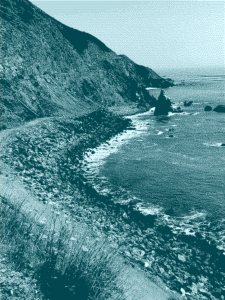The Harrowing Design and Friendliness of the Pacific Coast Highway
Driving and being driven

I’m a pretty experienced driver. Growing up on the East Coast means that you learn to navigate the highways and byways of the region with a bit of panache and more than a little bit of respect for sometimes maniacal drivers and crappy road conditions.
The Philadelphia suburbs, where I grew up, has decent (e.g. careful) drivers and well-maintained roads. New England and Upstate New York, where I spent most of my 20s, has superb roads and truly terrible drivers. New York City and its environs, where I spent most of my 30s, has horrible roads and excellent drivers. (It strikes me that the correlation between road conditions and driver competence is not an exact science — but Philly may be a good mean.)
Then there’s the West
California, however, is in category altogether on its own. There are probably few places in the world more designed around the automobile than the Great State of California. One of its most famous roadways, the Pacific Coast Highway (or Route 1), represents a kind of pinnacle of highway success, a road that broke the mold for all roads ever built.
I spent a few weeks in California last August. In the middle of our trip, we braved the PCH north from Los Angeles to San Francisco. Yes, I know. Most people like to go the opposite direction in order to better take in the phenomenal scenery. But we went South to North and I’m glad we did.
Imagine this: you are driving on a single lane, well-paved and well-demarcated highway. On your right are steep rocky cliffs and mountain walls blasted solid about one hundred years ago in order to make way automobiles. The flora on those cliffs and mountainsides are painfully stunning, painted green and blue and pink and red and brown and orange and various shades of rock. Sometimes the wall of rock on your right is a just few feet away. Other times, you can barely see all the way up the mountainside. On your left, driving north, are even steeper cliffs that drop down to the Pacific Ocean. Way, way down, if you so desire, you can see the foaming, fomenting ocean waves lapping against the California shore.
Meanwhile, you’re driving what? 30, 40 miles per hour. Maybe 50. In the occasional rest spot, Maseratis and Mercedes pass you on the left, their drivers focused entirely on the two lines that separate them from danger and mayhem. Sometimes, you’re driving 20 miles per hour and hairpin turns slowing you down to 15 or even 10 miles per hour. The entire experience of the PCH amounts to a barrage of deceleration, acceleration while somehow watching the scenery. And the whole time, you’re hoping that your kid isn’t about to throw up their breakfast.
Though it was designed for highway pleasure, I confess that the entire thing was a white knuckle affair for me. I only had one panic attack (well, maybe two) which I swallowed silently.
The Surprise of Courtesy
But here’s what I found most interesting. While the Pacific Coast Highway is imperfectly built (why not consistently install barriers for southbound cars?), it struck me that Californian drivers have developed an unwritten law of the Pacific Coast Highway that takes into account all levels of driving experience and willfulness.
Almost no one tailgated me or any other drivers. No one passed me in a huff, flooring it to get around the next curve. And when I was driving purposefully very slowly to take in the beauty before me, others behind me did as well, maybe giving breathing room to dozens of cars that followed.
Along the three hour drive on the PCH, it’s common to get out of your car and take in the scenery at established (and sometimes makeshift) viewpoints. Minivans pull over to the side of the road and families pile out with their smartphones to take a photo and breath in the ocean mist. Others are just taking a break or having a scenic snack (or recovering from a panic attack). There are also people crossing the road every which way, some not so safely.
The point is that these drivers of 4,000 pound steel vehicles navigating the death-defying roadways of the Pacific Coast Highway were calm, patient, and respectful. I did not expect this.
Yes, there is a bit of self-selection in who drives and does not drive the PCH. But in a culture that is increasingly designed for speed, in which rules for courteousness are often disregarded, and in which sensory experience is devalued, the PCH provides an uncodified standard for social behaviour even in the midst of potentially harrowing outcomes. Despite our reliance on petroleum-based transportation, that stretch of precarious highway in car-centric California, at least for me, represents a model for how we can get somewhere together, separately, while also not running each other off a cliff.